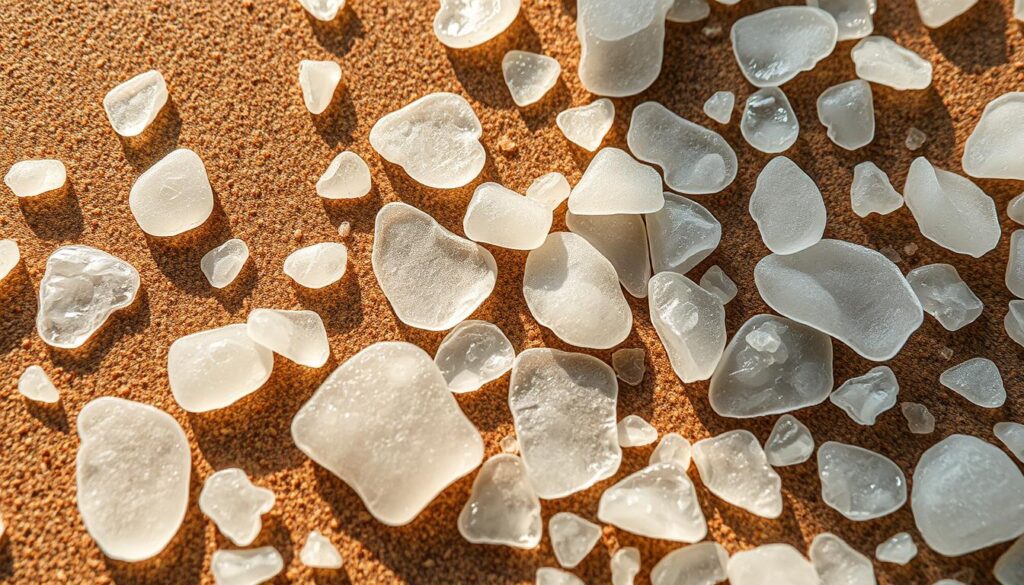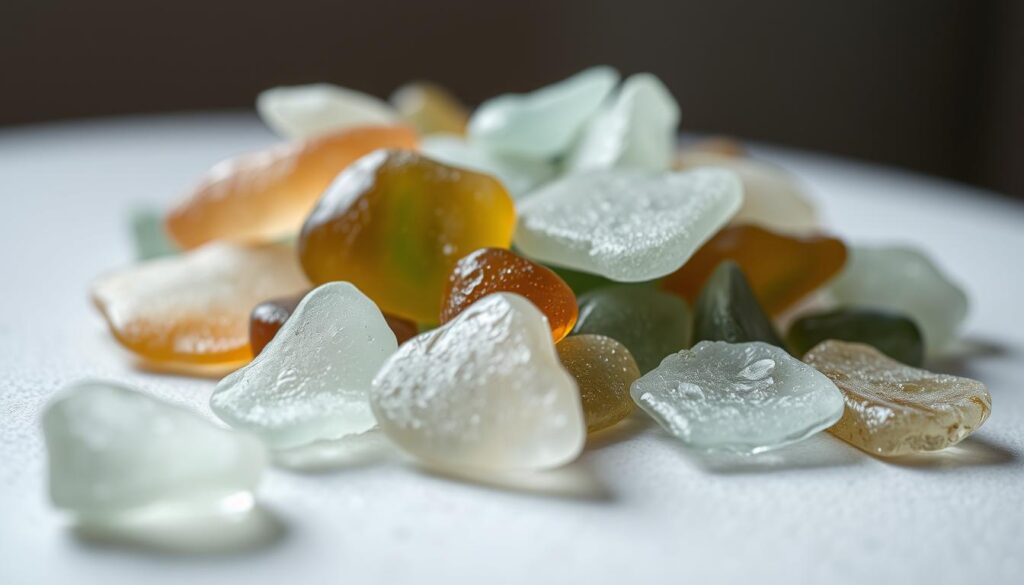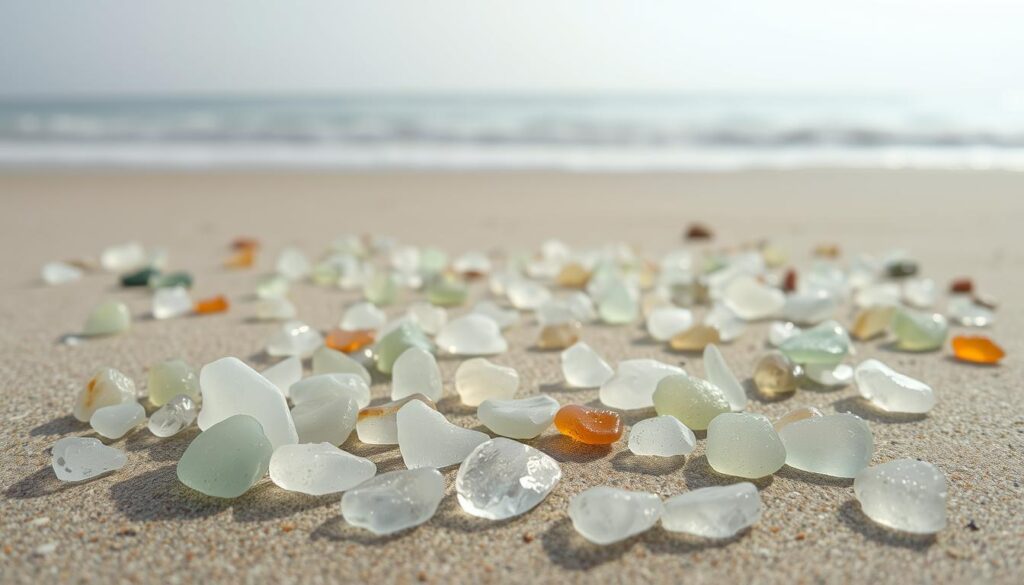For collectors and jewelry makers, genuine sea glass is highly prized, but distinguishing it from artificially tumbled glass can be challenging. The ocean’s decades-long transformation process gives real sea glass a unique character that is hard to replicate.
Understanding the differences between naturally formed sea glass and man-made alternatives is crucial, as genuine pieces have both historical significance and higher monetary value. To learn more about the characteristics of authentic real sea glass, this guide will walk you through the formation process, physical characteristics, and telltale signs that help you confidently identify it.
The Origins and Formation of Sea Glass
The formation of real sea glass involves a complex process that occurs naturally in ocean environments. Genuine sea glass begins its journey as discarded glass items such as bottles, jars, or tableware that find their way into oceans, lakes, or rivers.
What Is Genuine Sea Glass?
Genuine sea glass is glass that has been discarded in the ocean and tumbled naturally by waves and sand over many years. It’s not just any piece of glass that is frosted; real or genuine sea glass is aged by nature over many years and exposure to water and current. Real sea glass comes from old bottles, jars, and other glass items that have undergone significant transformation.
The process that turns glass into sea glass is natural and takes a considerable amount of time, typically between 20 to 50 years in ocean environments. This distinguishes it from artificially tumbled glass.
The Natural Aging Process
During the natural aging process, the continuous motion of waves, combined with the abrasive action of sand and rocks, gradually smooths the sharp edges of broken glass pieces. The chemical composition of the glass changes as seawater causes hydration, where sodium and lime in the glass are gradually replaced by elements from the water.
| Characteristics | Genuine Sea Glass | Artificially Tumbled Glass |
|---|---|---|
| Aging Process | Naturally aged over 20-50 years | Mechanically tumbled in a short time |
| Surface Texture | Unique, naturally smoothed | Uniform, may lack natural texture |
| Chemical Changes | Undergoes hydration and chemical changes | No significant chemical changes |
Understanding these differences is key to identifying genuine sea glass. The natural tumbling process creates unique characteristics that cannot be perfectly replicated by artificial means, including distinctive surface patterns and internal structural changes.
How to Identify Genuine Sea Glass vs. Tumbled Glass
Distinguishing between genuine sea glass and tumbled glass requires a keen eye for detail and an understanding of the characteristics that set them apart. When you’re searching for real sea glass, there are several factors to consider to ensure you’re getting authentic pieces.
Texture and Surface Characteristics
The texture of genuine sea glass is one of the most reliable indicators of its authenticity. Look for a distinctive frosted appearance with small “C” shaped abrasions caused by years of tumbling in the surf. Run your fingers over the surface; authentic pieces will have an uneven, pitted texture that artificial glass cannot perfectly replicate. If the texture is uniform and smooth, it may be fake sea glass.

Some genuine sea glass pieces may also exhibit tiny divots or a crystalline appearance that sparkles in the sun. The natural aging process, known as “hydration,” leaches the lime and soda out of the glass, giving it a rounded shape and frosty texture. This process is difficult to replicate artificially, making texture a crucial factor in identifying real sea glass.
Shape and Edge Analysis
Shape analysis is also crucial for identification. Genuine sea glass typically has irregular, organic shapes with varying thickness, while machine-tumbled glass often has more uniform dimensions and predictable contours. Examine the edges of the glass; real sea glass edges are typically more frosted than the surface and may show varying degrees of wear on the same piece.
In contrast, fake sea glass tends to have consistent wear patterns. The edge examination can reveal important differences between genuine and artificial sea glass, helping you make informed decisions when purchasing or collecting.
Color Authenticity Assessment
Color assessment requires knowledge of historical glass production. Certain colors like red, orange, purple, and some blues are extremely rare in genuine sea glass, so an abundance of these colors at low prices is a warning sign. Understanding the difference between the natural patina of real sea glass and the artificial frosting of tumbled glass will help you identify authentic pieces.
By carefully examining the texture, shape, and color of the glass, you can effectively tell the difference between real sea glass and fake sea glass, ensuring that your collection is comprised of authentic, naturally weathered pieces.
Key Physical Indicators of Authentic Sea Glass
To verify if a piece of glass is genuine sea glass, look for specific physical traits that have developed over time due to its interaction with the ocean environment. These characteristics not only help in distinguishing real sea glass from artificially tumbled glass but also provide insights into its history and authenticity.
The “C” Shaped Abrasions and Pitting
One of the definitive characteristics of genuine sea glass is the presence of “C” shaped abrasions and pitting on its surface. Under magnification, these appear as small curved indentations created by the varied sizes of sand and gravel in the ocean. This unique texture is a result of years of tumbling in the surf, making it a strong indicator of real sea glass.
The process of forming these abrasions is gradual, involving the constant interaction between the glass, sand, and gravel. As a result, the surface of genuine sea glass often exhibits a distinctive texture that is rarely replicable in artificially tumbled glass.
Frosting and Hydration Signs
Authentic sea glass often displays a distinctive frosting that results from decades of hydration in seawater. This frosting is not just a surface phenomenon but is caused by the breakdown of the glass structure due to salinity, leading to hydroxide leaching to the surface. It’s essential to note that this frosting is not salt residue but a sign of the glass’s prolonged exposure to seawater.
Upon removal from the water, the crystalline formations or frost on real sea glass become visible, providing a clear visual cue about its authenticity.
Thickness, Curvature, and Bubbles
Several other physical indicators can help verify the authenticity of sea glass. The thickness of genuine sea glass often indicates its age, with older pieces tend to be thicker due to the manufacturing processes used at the time. Additionally, many genuine sea glass pieces retain the curved shape of their original container, a characteristic that is less common in artificially tumbled glass made from flat glass sheets.
- Air bubbles trapped within the glass can also indicate authenticity, as they’re common in older, hand-blown glass items.
- The combination of these features – thickness, curvature, and air bubbles – provides strong evidence of a piece of glass being genuine sea glass.
When examining a piece of suspected sea glass, it’s crucial to look for these physical indicators collectively rather than relying on just one characteristic. The presence of multiple indicators significantly strengthens the case for its authenticity.
Red Flags: Spotting Artificial or Fake Sea Glass
Identifying authentic sea glass requires a keen eye for detail, particularly in recognizing the red flags that indicate artificial or fake pieces. As you explore collections or marketplaces, being aware of these indicators can save you from purchasing fake sea glass.
Uniform Texture and Appearance
Artificially tumbled glass often exhibits a suspiciously uniform texture and appearance, lacking the natural variation found in genuine sea glass that has been shaped by unpredictable ocean conditions. Genuine sea glass typically shows some degree of vitrification upon close inspection.

Identical Shapes and Geometric Patterns
Be wary of collections featuring multiple pieces with identical or very similar geometric shapes – nature rarely creates such uniformity, while machine processing often does. Although natural sea glass can have angular shapes, an assortment of pieces with the same shape is likely to be man-made.
Suspicious Pricing of “Rare” Colors
One of the most telling red flags is the pricing of supposedly rare colors – authentic red, orange, purple, and certain blue sea glass pieces are extremely rare and command high prices. Abundant supplies at low prices indicate artificial production, particularly for rare colors like pink or lavender.
Manufacturing Techniques Used for Fakes
Manufacturing techniques for fake sea glass include mechanical tumbling with uniform abrasives, acid etching to create artificial frosting, and even dyeing clear glass to mimic rare colors. Additionally, frosted glass beads marketed as “sea glass” are common in the craft market, but these mass-produced items lack the authentic characteristics of genuine sea glass.
The Value and Significance of Genuine Sea Glass
Understanding the true value of genuine sea glass requires considering its historical context, aesthetic appeal, and environmental implications. As a unique and rare natural treasure, genuine sea glass continues to captivate collectors and artisans alike.
Rarity and Collector Appeal
Genuine sea glass is highly prized by collectors for its historical significance and aesthetic appeal. As environmental awareness has reduced the amount of glass entering oceans, new sea glass has become increasingly scarce, driving up its value. For instance, reputable sellers provide detailed information about their sea glass sources, adding to its authenticity and value.
Collectors value authentic sea glass not just for its beauty but also for the story it tells. Each piece represents a tangible connection to the past, often carrying a unique history. The rarity of genuine sea glass, combined with its natural beauty, makes it a highly sought-after material for crafting sea glass jewelry.
Ethical Considerations in the Sea Glass Market
The sea glass market is influenced by ethical considerations, including transparency about origins and authenticity. Reputable sellers provide detailed information about their sea glass sources and often belong to organizations like the North American Sea Glass Association. This transparency is crucial in maintaining the integrity of the sea glass market.
The sustainable nature of genuine sea glass also appeals to environmentally conscious consumers. It represents the transformation of discarded waste into something beautiful, giving it special significance in today’s eco-aware marketplace. By choosing genuine sea glass, consumers support artisans who work with authentic materials, promoting a more sustainable and responsible market.
Conclusion
Empowered with the right knowledge, you can now differentiate between real sea glass and its artificially created counterparts. Learning to identify genuine sea glass versus artificially tumbled glass empowers you to make informed decisions whether you’re a collector, jewelry maker, or simply appreciate these ocean treasures.
The key differences between real sea glass and fake alternatives lie in their texture, shape, color authenticity, and physical characteristics that develop only through decades of natural ocean tumbling. As you develop your eye for authentic sea glass, consider joining communities like the North American Sea Glass Association to further your knowledge and connect with other enthusiasts.
When purchasing sea glass jewelry, don’t hesitate to ask sellers about the provenance of their materials. By supporting artisans who use authentic sea glass in their creations, you help preserve the tradition and craftsmanship associated with these unique beach treasures. Understanding the difference between real and fake ensures you can fully appreciate the unique beauty and value of genuine sea glass.
